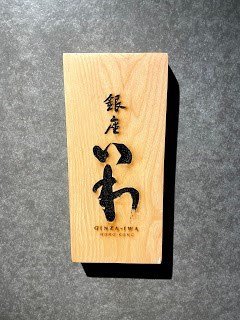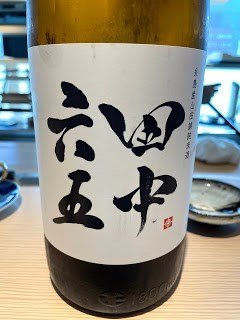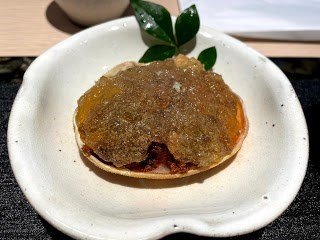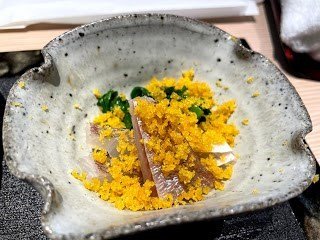
銀座いわ 銅鑼灣
地址: 銅鑼灣駱克道459-461號TheL.Square17樓
最後更新:
銀座いわ推介


This Japanese sushi restaurant is located in Causeway Bay L. Square, with only 6 seats on the sushi counter and a private room. Opened just recently, I came to know of this restaurant after seeing my friend posted the photos on facebook. Coming during lunch hours as no dinner service is available because of government restriction, we were seated in front of Chef Motoyama Taichiro. He ran the whole show throughout and is very friendly and can also speak a bit of Cantonese. We ordered the Omakase Menu ($2,000 each) and asked for the sake recommendation. The first sake I tasted came from Fukuoka Itoshima Shiraito Brewery 福岡県糸島市 白糸酒造 田中六五, as I understood that Chef Motoyama also come from Fukuoka. The restaurant offers ichigo (180 ml) portion so you can sample different sake during the meal. The first course is Kobakogani 香箱蟹. The seasonal delicacy, this is the female snow crab that can only be caught during November and December. The delicate crab meat is mixed with a lot of the flavorful crab roes, and the chef added an abundance of jelly which added a bit of acidity to further liven up the taste buds. The second course is Tai 鯛, with some seasonal vegetable underneath and then the chef shaved the homemade karasumi 唐墨 (or 烏魚子). The mild taste of the fish is complemented with the intense flavors of the salted mullet roes. This one was my wife's favorite in the whole meal. The third course is Raw Oyster ガキ, with the chef mixing with some ponzu dressing, chives and radish. I like the small size of the oyster, and the chef had also cut in halves to facilitate eating. Silky on texture, it is very fresh and tasty.The fourth course is Wild Hirame 平目 and Otoro 大とろ. The flatfish has a delicate mild taste and got a great texture, with nice bite while the fatty tuna is full of fish oil and intense on the palate, but offering a contrasting softer texture. Both are wonderful pieces of sashimi.Seeing the chef put a nice coffee cup in front of us, we wonder what is the fifth course. Then he brought out a pan from the kitchen and pour in a great Fish Soup, with its fragrance so nice that I can smell from afar. Adding plenty of chives, the soup has bursting flavors, so concentrated that it must take a lot of fish to prepare. A warming and great intermittent in the meal.The sixth course is Hamachi ハマチ, or Japanese amberjack, with the winter season the fish getting more fatty. The chef used the torch gun to lightly sear the outside before cutting into slices, liven up the fish oil and intensify the flavors. With some chives to accompany, the texture is soft and a very nice piece.Finishing my first sake, I ordered the next one. The chef picked one from Fukuchiyo Brewery, 富久千代酒造, 鍋島純米吟醸 山田錦. This sake is much sweeter than the first one, and more intense on the rice notes, which I think is better to pair with the sushi coming.The seventh course is Edamame 枝豆. The specialty of this one is that the chef had cooked the beans in a broth to infuse them with additional flavors, and then provided some nice sea salt to accompany. But even without adding the salt I found the beans so great that I cannot stop and want to have more. The eighth course is Threadfin. The chef used deepfry technique to cook the fish, creating a nice presentation with the scales standing up, also making the skin crispy and the scales edible, while keeping the flesh still moist and tender. A true example of the chef's cooking skills.The ninth course is an assortment of three things: Octopus 章魚, Monkfish Liver 鮟肝 and Salted Mullet Roes 唐墨. The octopus has been braised beautifully, soft and completely chewable, with the sauce integrated into the octopus. But among the three I like the monkfish liver most. It is melting in the mouth, with a creamy texture and heavenly taste. The homemade salted mullet roes is good too, after being toasted on fire the aromas and flavors are enhanced. Moving to the sushi now, the first piece is Aji 鯵. Nice taste of the fish with a bit of ginger added to repel the slight fishy note of this silvery fish delicacy. Good one.The second piece is Kinmedai 金目鯛. The beautiful red skin and the soft flesh of the fish is always prized as one of the favorites in sushi restaurants. I found the flesh very tender and guess the chef must have aged the fish before use. Another good one.And by then I finished my second sake. Going for the third, the chef recommended 黒龍酒造 吟醸 「いっちょらい」. This sake is lighter, more elegant and refreshing than the last one. Chef Motoyama seems a bit surprised by how much sake I can drink though...The third piece of sushi is Ika 烏賊. The squid has been carefully cut by the chef to break the fiber, and then the chef sprinkled some yuzu shavings on top. It did wonders as the yuzu added a nice fragrance to the light flavors of the squid. But I always think enjoying this one is on the texture and how amazing the chef can make one rubbery piece of squid so tender. The fourth piece is Akami, the leaner part of the tuna. The chef used a special sauce to marinate the fish for a while to infuse with flavors and also reduce the irony taste of the flesh. My wife enjoyed this as she cannot handle the more fatty belly of the tuna. The fifth piece is one of my favorites among the sushi. Sayori 針魚 is a small fish of slender shape, and transparent on the flesh, allowing us to see through to the sushi rice underneath. Very fresh and tasty, the delicate flavors of the fish is a great seasonal sushi one must try.The sixth piece is Kurumaebi 車海老, another of my favorites in this meal. The chef brought out a grilled prawn and then removed the shell while it is still very hot. Then cutting it in the middle and then added the sushi rice. The sweetness of the prawn is amazing and the size of the prawn means I need to eat in three bites. Another musttry. The seventh piece is Otoro, and the fatty tuna belly has some beautiful marble texture on the flesh. Biting it the softness feels like dissolving in the mouth, and the fish oil is also rich and creates a satisfying enjoyment which is probably the reason why this sushi is so sought after. The eighth piece is Kohada 小鰭, a small fish with many dark spots on the skin. The chef put three fillets on the sushi, and the silvery fish has a rich taste but can be regarded as bit fishy on the note. My wife does not like it but I think it is one of the most delicious. Well, this fish can be polarized in the preference.The name of the ninth piece I could not remember. But what I recalled is that the fish has got a nice soft and tender texture, with nice flavors and also the chef retained a 'tail' of engawa (or skirt) to offer a nice contrasting bite. The sprinkle of yuzu shaves is again able to freshen up the sushi tremendously.The tenth piece is Uni, and the chef used a piece of seaweed to wrap up the sushi, with abundance of sea urchin on top, to pass it over. The sea urchin is sweet and without any strange taste, really of high quality, and the creamy texture is rewarding and fulfilling.The eleventh piece is Anago 穴子. The sea eel is grilled and then brushed with a homemade sauce. With the eel still warm from the grill, the melting texture of the flesh, and the sweet and savory flavors from the sauce it is a great harmony of taste. Another musttry. The chef also provided a piece of Tamagoyaki, or egg, which has been cooked together with a nice broth as I can taste a fantastic note from the silky smooth egg. The last piece is Ikura 筋子, with the chef making a sushi roll from the salted salmon roes, which are marinated perfectly, with a nice savory note but not overly salty. A great finale to the sushi and also unlike some omakase set, this one we felt full in our stomach and each piece is equally impressive.We are then served the Miso Soup with Clams, with the soup rich in umami from the miso and clams, and drinking it down warms our stomach and giving us a great sense of satisfaction and happiness. Last we have the dessert. It is a slide of Melon with Strawberry. The melon is a prized fruit for the season, and seeing the chef taking the whole melon and then cut it open feel even more premium. Both the melon and strawberry are very sweet. A great finale to the whole meal.The service is great, with only the 6 people sitting around the counter both the chef and the staff is very busy looking after us but they are still able to offer nice smile and friendly chats throughout. The bill is $4,807 and with the omakase and the three servings of sake it is reasonable in my opinion. A definite choice to return in the future.
銅鑼灣銀座いわ
| 餐廳分店 | 銀座いわ |
|---|---|
| 地區 | 銅鑼灣 |
| 電話訂位 | 28042004 |
| 餐單 Menu | 日本菜, |
| 人氣指數 | 426 |
| 價錢幾錢 | $801以上 |
銀座いわ訂位
銀座いわ位於銅鑼灣區,詳細地址是銅鑼灣駱克道459-461號TheL.Square17樓,餐廳寬敞座位數目共有未知幾多個。銀座いわ幾錢?價錢優惠後人均消費大約$801以上埋單,早餐午餐晚餐銀座いわ餐單包括有日本菜等美食,付款方式有現金付款,Booking網上訂位可以電話致電 28042004 查詢訂座。銀座いわ優惠
銀座いわ 評價 相片
This Japanese sushi restaurant is located in Causeway Bay L. Square, with only 6 seats on the sushi counter and a private room. Opened just recently, I came to know of this restaurant after seeing my friend posted the photos on facebook. Coming during lunch hours as no dinner service is available because of government restriction, we were seated in front of Chef Motoyama Taichiro. He ran the whole show throughout and is very friendly and can also speak a bit of Cantonese. We ordered the Omakase Menu ($2,000 each) and asked for the sake recommendation. The first sake I tasted came from Fukuoka Itoshima Shiraito Brewery 福岡県糸島市 白糸酒造 田中六五, as I understood that Chef Motoyama also come from Fukuoka. The restaurant offers ichigo (180 ml) portion so you can sample different sake during the meal. The first course is Kobakogani 香箱蟹. The seasonal delicacy, this is the female snow crab that can only be caught during November and December. The delicate crab meat is mixed with a lot of the flavorful crab roes, and the chef added an abundance of jelly which added a bit of acidity to further liven up the taste buds. The second course is Tai 鯛, with some seasonal vegetable underneath and then the chef shaved the homemade karasumi 唐墨 (or 烏魚子). The mild taste of the fish is complemented with the intense flavors of the salted mullet roes. This one was my wife's favorite in the whole meal. The third course is Raw Oyster ガキ, with the chef mixing with some ponzu dressing, chives and radish. I like the small size of the oyster, and the chef had also cut in halves to facilitate eating. Silky on texture, it is very fresh and tasty.The fourth course is Wild Hirame 平目 and Otoro 大とろ. The flatfish has a delicate mild taste and got a great texture, with nice bite while the fatty tuna is full of fish oil and intense on the palate, but offering a contrasting softer texture. Both are wonderful pieces of sashimi.Seeing the chef put a nice coffee cup in front of us, we wonder what is the fifth course. Then he brought out a pan from the kitchen and pour in a great Fish Soup, with its fragrance so nice that I can smell from afar. Adding plenty of chives, the soup has bursting flavors, so concentrated that it must take a lot of fish to prepare. A warming and great intermittent in the meal.The sixth course is Hamachi ハマチ, or Japanese amberjack, with the winter season the fish getting more fatty. The chef used the torch gun to lightly sear the outside before cutting into slices, liven up the fish oil and intensify the flavors. With some chives to accompany, the texture is soft and a very nice piece.Finishing my first sake, I ordered the next one. The chef picked one from Fukuchiyo Brewery, 富久千代酒造, 鍋島純米吟醸 山田錦. This sake is much sweeter than the first one, and more intense on the rice notes, which I think is better to pair with the sushi coming.The seventh course is Edamame 枝豆. The specialty of this one is that the chef had cooked the beans in a broth to infuse them with additional flavors, and then provided some nice sea salt to accompany. But even without adding the salt I found the beans so great that I cannot stop and want to have more. The eighth course is Threadfin. The chef used deepfry technique to cook the fish, creating a nice presentation with the scales standing up, also making the skin crispy and the scales edible, while keeping the flesh still moist and tender. A true example of the chef's cooking skills.The ninth course is an assortment of three things: Octopus 章魚, Monkfish Liver 鮟肝 and Salted Mullet Roes 唐墨. The octopus has been braised beautifully, soft and completely chewable, with the sauce integrated into the octopus. But among the three I like the monkfish liver most. It is melting in the mouth, with a creamy texture and heavenly taste. The homemade salted mullet roes is good too, after being toasted on fire the aromas and flavors are enhanced. Moving to the sushi now, the first piece is Aji 鯵. Nice taste of the fish with a bit of ginger added to repel the slight fishy note of this silvery fish delicacy. Good one.The second piece is Kinmedai 金目鯛. The beautiful red skin and the soft flesh of the fish is always prized as one of the favorites in sushi restaurants. I found the flesh very tender and guess the chef must have aged the fish before use. Another good one.And by then I finished my second sake. Going for the third, the chef recommended 黒龍酒造 吟醸 「いっちょらい」. This sake is lighter, more elegant and refreshing than the last one. Chef Motoyama seems a bit surprised by how much sake I can drink though...The third piece of sushi is Ika 烏賊. The squid has been carefully cut by the chef to break the fiber, and then the chef sprinkled some yuzu shavings on top. It did wonders as the yuzu added a nice fragrance to the light flavors of the squid. But I always think enjoying this one is on the texture and how amazing the chef can make one rubbery piece of squid so tender. The fourth piece is Akami, the leaner part of the tuna. The chef used a special sauce to marinate the fish for a while to infuse with flavors and also reduce the irony taste of the flesh. My wife enjoyed this as she cannot handle the more fatty belly of the tuna. The fifth piece is one of my favorites among the sushi. Sayori 針魚 is a small fish of slender shape, and transparent on the flesh, allowing us to see through to the sushi rice underneath. Very fresh and tasty, the delicate flavors of the fish is a great seasonal sushi one must try.The sixth piece is Kurumaebi 車海老, another of my favorites in this meal. The chef brought out a grilled prawn and then removed the shell while it is still very hot. Then cutting it in the middle and then added the sushi rice. The sweetness of the prawn is amazing and the size of the prawn means I need to eat in three bites. Another musttry. The seventh piece is Otoro, and the fatty tuna belly has some beautiful marble texture on the flesh. Biting it the softness feels like dissolving in the mouth, and the fish oil is also rich and creates a satisfying enjoyment which is probably the reason why this sushi is so sought after. The eighth piece is Kohada 小鰭, a small fish with many dark spots on the skin. The chef put three fillets on the sushi, and the silvery fish has a rich taste but can be regarded as bit fishy on the note. My wife does not like it but I think it is one of the most delicious. Well, this fish can be polarized in the preference.The name of the ninth piece I could not remember. But what I recalled is that the fish has got a nice soft and tender texture, with nice flavors and also the chef retained a 'tail' of engawa (or skirt) to offer a nice contrasting bite. The sprinkle of yuzu shaves is again able to freshen up the sushi tremendously.The tenth piece is Uni, and the chef used a piece of seaweed to wrap up the sushi, with abundance of sea urchin on top, to pass it over. The sea urchin is sweet and without any strange taste, really of high quality, and the creamy texture is rewarding and fulfilling.The eleventh piece is Anago 穴子. The sea eel is grilled and then brushed with a homemade sauce. With the eel still warm from the grill, the melting texture of the flesh, and the sweet and savory flavors from the sauce it is a great harmony of taste. Another musttry. The chef also provided a piece of Tamagoyaki, or egg, which has been cooked together with a nice broth as I can taste a fantastic note from the silky smooth egg. The last piece is Ikura 筋子, with the chef making a sushi roll from the salted salmon roes, which are marinated perfectly, with a nice savory note but not overly salty. A great finale to the sushi and also unlike some omakase set, this one we felt full in our stomach and each piece is equally impressive.We are then served the Miso Soup with Clams, with the soup rich in umami from the miso and clams, and drinking it down warms our stomach and giving us a great sense of satisfaction and happiness. Last we have the dessert. It is a slide of Melon with Strawberry. The melon is a prized fruit for the season, and seeing the chef taking the whole melon and then cut it open feel even more premium. Both the melon and strawberry are very sweet. A great finale to the whole meal.The service is great, with only the 6 people sitting around the counter both the chef and the staff is very busy looking after us but they are still able to offer nice smile and friendly chats throughout. The bill is $4,807 and with the omakase and the three servings of sake it is reasonable in my opinion. A definite choice to return in the future.
您對於銅鑼灣餐廳「銀座いわ」有何comment?
銀座いわ餐廳詳細資料:
- 銀座いわ地址: 銅鑼灣駱克道459-461號TheL.Square17樓 Ginza Iwa, 17/ F, The L. Square,459-461 Lockhart Road, Causeway Bay
- 銀座いわ電話: 28042004
- 銀座いわ價錢: $801以上
- 分類: 日本菜,
- 座位: 未知
- 付款: 現金
- FB專頁: 銀座いわ Facebook
更多銀座いわ相關資料:
香港餐廳2023推介04月
為減低冠狀病毒病在Subway內有任何傳播的風險,Subway在餐廳內會盡力保持高水平的清潔及衞生標準。餐廳Subway除了遵守預防及控制疾病的相關規例,Subway同時建議採取以下措施*Subway 黃, Subway 藍, (Subway 黃藍 等意思黃店或藍店簡稱
常見問題 FAQ:
銀座いわ在餐廳內應如何確保環境衞生?
- 食物業經營者應加強對食物業處所包括廚房、食物房、洗滌間、廁所(包括水龍頭與廁所把手)和食肆座位間的清潔,定時及在有需要時應用1:99(即把1份漂白水與99 份水混和)的稀釋家用漂白水消毒,以經常保持清潔和適當維護。
- 在處理被呼吸道分泌物、嘔吐物或排泄物污染的地方,應使用 1:49(即把 1 份漂白水與 49 份水混和)的稀釋家用漂白水。
- 經常清潔消毒食物接觸面及設備,例如餐具。
- 經常清潔消毒員工或顧客的頻密接觸點,例如門柄、桌面、餐盤。
- 確保用作送遞食物的工具不可用於收集餐桌上已使用的餐具及食物殘渣,可考慮以不同顏色或標示來識別工具的不同用途。所有工具都要保持清潔和定時消毒。
餐廳廚房內銀座いわ應如何確保食物衞生?
- 採用「食物安全五要點」,以正確處理食物:
- 精明選擇:選擇安全的原材料
- 保持清潔:保持雙手及用具清潔
- 生熟分開:分開生熟食物
- 煮熟食物:徹底煮熟食物
- 安全溫度:把食物存放於安全溫度
- 有需要時,提供公筷公羹。
- 避免公開展示沒有包裝的即食食物(例如烘焙食品)。
- 如使用即棄手套處理即食食物,要注意手套不能代替清洗雙手,並要正確使用。手套如有損壞、弄污或食物處理人員因暫停工作而把手套除下,便應把手套丟掉;要經常更換手套,更換時和除手套後都要清洗雙手。
對於工的個人衞生餐廳銀座いわ建議是什麼?
- 工作人員須謹記:定期檢查體溫
- 工作期間,戴上口罩
- 咳嗽或打噴嚏時,要用紙巾掩蓋口鼻,並立即將已弄髒的紙巾丟入垃圾桶。然後,以梘液和清水清潔雙手
- 保持良好的個人衞生習慣(例如在處理食物前後、進行清潔之後、處理廚餘或垃圾後以及上廁所後要洗手)
- 如患有或懷疑受到傳染病感染或出現病徵,例如感冒、腹瀉、嘔吐、黃疸病、發燒、咽喉痛和腹痛,應停止處理食物。如出現呼吸道感染病徵時,應戴上外科口罩及盡早求醫
- 洗手時應以梘液和清水清潔雙手,搓手最少 20 秒,用水過清並用抹手紙弄乾。雙手洗乾淨後,不要再直接觸摸水龍頭 (例如先用抹手紙包裹著水龍頭,才把水龍頭關上)
銀座いわ餐廳內大家應如何減少社交接觸?
- 為採取以下措施保持員工之間、員工與顧客之間以及顧 客之間的社交距離:
- 為顧客提供外賣選擇
- 避免搭枱或改動座位安排以減少直接面對面接觸
- 在食肆張貼告示或作廣播、或於地面加上標記、提醒顧客在排隊或等候期間保持距離
- 在服務櫃枱加設屏障,減少顧客與員工直接面對面接觸
- 鼓勵顧客使用非觸式的付款方法(例如:信用卡、手機應用程式等)
- 安排員工分批工作、休息及用膳



